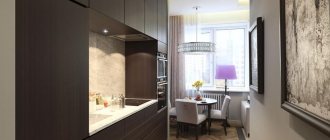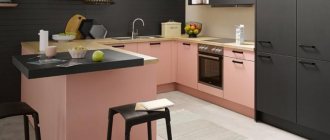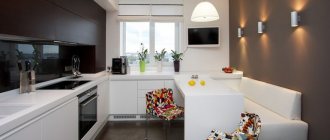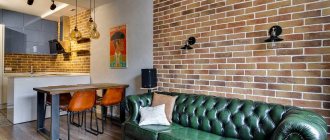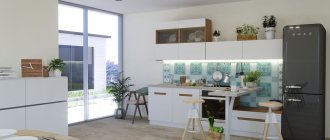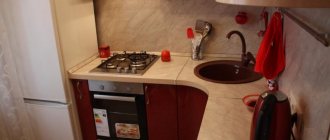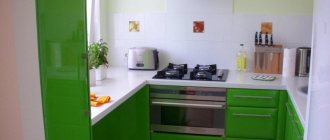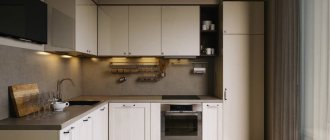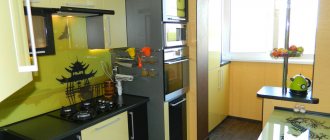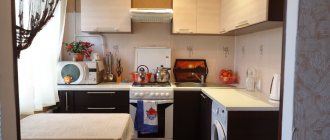In some kitchens, part of the space belongs to the ventilation duct. It becomes a problem when developing a design. It is important to take into account all the nuances in order to beat this circumstance profitably. The design of a kitchen with a ventilation duct involves many features. Useful recommendations will help you create a beautiful interior.
In almost all apartments, the kitchen is a small room, so every meter counts.
And how lost apartment owners are when they discover that part of the usable area where food should be prepared is occupied by a ventilation duct.
What types of ventilation ducts are there?
The box may have modest dimensions and take up little space. Or have a large size, which causes a lot of inconvenience. It is important that the structure cannot be dismantled for safety reasons. The box can be located in a corner or at the entrance. Most of them are rectangular in shape.
The presence of such a detail confuses many people, because it does not allow the use of headsets created for a standard layout and the implementation of many ideas.
The design of a kitchen with a ventilation duct requires a special approach and a non-standard solution to the problem of an unsuccessful layout.
Furniture and interior items
8 votes
+
Vote for!
—
Vote against!
The kitchen is a room where the aesthetic component of the design must be combined with the functionality and practicality of its solutions. And if the owners of spacious kitchens, using the information gleaned after familiarizing themselves with Internet resources, are more or less free in their actions, then the owners of apartments with small kitchens are extremely limited in the choice of current design solutions. But a small kitchen area is far from a death sentence. In connection with the development of the construction industry, aimed at the construction of standard economy-class apartments, where a small-sized kitchen is an integral element of the layout, most Internet resources offer many current interior solutions for small-sized kitchens. However, in most cases, these recommendations are relevant for kitchens of small sizes, but with a standard layout. But what should those whose kitchens have any non-standard layout features do? Often these features include a ventilation duct, the presence of which confuses most owners. How to plan a kitchen unit if there is a ventilation duct in the most visible place in the room? How can you beat this design flaw and turn it into an advantage and a kind of “highlight” of the kitchen? Find answers to these and other questions related to the design of a kitchen with a ventilation duct, as well as the features of its installation, in our article.
Content
- What is a ventilation duct: it cannot be removed and left
- Shape and location features of the ventilation duct
- What should you consider when finishing a ventilation duct?
- How to mask a ventilation duct: solving the problem
- Option No. 1. Manufacturing of kitchen furniture to order
- Option No. 2. Installation of a ready-made L-shaped set
- Functional masking of the ventilation duct
- Options for decorative masking of the ventilation duct
- Installation of ventilation ducts: step-by-step guide
- Preparatory activities: how to determine the parameters of air ducts
- Ventilation duct installation technology
- Some features of installing ventilation ducts
What is a ventilation duct: it cannot be removed and left
If you decide to improve the interior of a kitchen with a ventilation duct, you must clearly understand the limits to which you are limited in the remodeling process. To clearly navigate this situation, you will need to study the ventilation duct diagram, which can be obtained from the developer or from the housing management office. The basis of a standard air duct is made up of air inflow and outflow valves, the total number of which does not exceed three. They are the ones who connect the ventilation duct with the general ventilation shaft. Having such a diagram in hand, you can reduce the size of the ventilation duct by simply replacing the existing ventilation sleeve with a smaller one.
Due to the fact that this engineering installation does not fit into the harmonious design of the room at all, many have probably thought about remodeling the kitchen and completely getting rid of the ventilation duct. We competently state: “It is prohibited to dismantle the duct!” Therefore, it is necessary to carefully study the issue related to the design of a kitchen with a ventilation duct. But even if you only plan to visually reduce the ventilation duct, this is not a reason to relax, since it is important to observe some of the features of the kitchen space and follow the practical recommendations of the experts.
Important! If you carry out incorrect and thoughtless intervention in the ventilation system, at a minimum, mistakes made as a result of your ignorance will cause an ineffective outflow of odors from the room, and, at a maximum, will cause a threat to your life and the lives of your neighbors in the event of a gas leak.
Shape and location features of the ventilation duct
Let's look at the most common types of ventilation ducts:
- Small structures, width/depth not exceeding 60 cm;
- Structures of larger dimensions, the width or depth of which exceeds 60 cm;
As for the shape of the ventilation duct, there are:
- Rectangular ventilation duct;
- The ventilation duct is of irregular geometric shape.
Most often, the layout of the room is carried out in such a way that the ventilation duct is located in one of the corners of the kitchen, and most often it is a corner located next to communications. There is also a location of the ventilation duct along one of the kitchen walls. If the ventilation duct is angular or small in size, you have the opportunity to fit it into the kitchen interior almost painlessly, but in all other cases you will have to make a lot of effort.
Kitchens with ventilation duct photo
What should you consider when finishing a ventilation duct?
If you want to turn your air duct into the highlight of your kitchen, there are a number of ways you can go, but your final course of action depends on the following factors:
- The location of the structure and its place in the kitchen project with a ventilation duct;
- Ventilation box size;
- The presence or absence of certain materials;
- General stylistic concept of the kitchen;
- The funds you plan to spend on furnishing your kitchen.
To choose the best option for finishing the ventilation duct and orient yourself with a plan for further action, first of all, analyze the planning features of your kitchen. Draw a general or more detailed plan on paper and study similar kitchen designs with a ventilation duct. If you are planning to purchase a custom-made kitchen set, you will need to study the design of the set in a graphic image, which will clearly indicate the dimensions of each element of the set. Also, in the process of choosing the finish of the ventilation duct, it is necessary to take into account the following features of the kitchen space:
- The location of the gas stove near the ventilation duct. In this case, it is necessary to categorically exclude wallpaper and vinyl siding from the list of possible finishing materials, the use of which is fraught with fire;
- If there is a sink near the ventilation duct, it is also not allowed to use wallpaper (with the exception of moisture-resistant samples) and decorative plaster as a finishing material.
How to mask a ventilation duct: solving the problem
Option No. 1. Manufacturing of kitchen furniture to order
The presence of a ventilation duct in the corner of the kitchen is not a reason to despair and give up, because you can properly equip it by relying on the use of decorative details, such as:
- Wall cabinets;
- Various shelves, valuable from a functional point of view;
- Decorative elements.
Due to the fact that the main question that worries owners of kitchens with a ventilation duct is: “What is the most optimal way to arrange the kitchen set so that it fits into the interior of the room?”, it should be noted that experts in this case recommend purchasing custom-made furniture in accordance with with the dimensions of your kitchen.
Important! When installing a kitchen unit, rely on specialists who will carry it out taking into account the depth of the ventilation duct and the curvature of its corners and the walls of the room.
Option No. 2. Installation of a ready-made L-shaped set
An alternative to custom-made furniture is to purchase a ready-made L-shaped set that needs to be installed in a corner. This solution to the problem will be the most optimal for medium-sized kitchens, the size of which is at least 9 square meters. meters. If you prefer this option, in the place where the ventilation duct is located (most often in the corner), install a shallow floor cabinet equipped with open shelves. If all the furniture included in the kitchen set is successfully located along one of the kitchen walls, it is also recommended to install a shallow floor cabinet in front of the ventilation duct. Having followed these recommendations, proceed with the installation of a traditional kitchen range, which includes:
- Tabletop (working surface);
- Dishwasher;
- Hob.
Important! One of the most current professional tips regarding masking a ventilation duct is to integrate it into furniture. For example, you can successfully hide the ventilation duct from prying eyes by integrating it into a wall cabinet, which is part of the kitchen unit.
Functional masking of the ventilation duct
Most often, designers have to deal with kitchens with a ventilation duct in the corner, which takes up a significant part of the free space. Despite this, this disadvantage, as if by magic, can be turned into an advantage by giving this structural element a functional purpose. For example, our experts recommend installing the following functionally significant elements in place of the ventilation duct:
- Many different shelves for storing souvenirs, dishes or spices;
- A bracket on which you can place a TV or DVD player. One of the walls of the ventilation duct can be used as a platform for installing a plasma panel;
- In addition, the installation of a bar counter, a kitchen island, or the installation of a portal for a false fireplace installed in the area of the ventilation duct will provide additional camouflage of the protrusion.
Important! If your kitchen is designed in such a way that you do not have the opportunity to profitably use the ventilation duct in terms of functionality, turn it into an interior element.
Options for decorative masking of the ventilation duct
The ventilation duct is an authentic column. Going for an antique and bold decorative finish, you can transform an unsightly duct into an authentic Mediterranean-style column, using imitation natural stone or plaster tiles for greater effect. And if you purchase textured plaster, you will be able to advantageously focus attention on individual structural elements;
The central element of the interior . You can turn the ventilation duct into the central element of the interior by decorating it with colorful ceramic mosaics or mirror tiles. If your kitchen is decorated in a modern loft style, you have another option for decorating a protruding structure - finishing the box with brick tiles made from concrete;
Decorating a plasterboard niche is another opportunity to functionally equip a ventilation duct on which you can attach shelves for decorative dishes or souvenirs;
Using the same materials is the most common way to disguise a ventilation duct. If you decorate it, as well as the adjacent areas of the kitchen area, with the same materials (tiles, wallpaper or textured paint), and also create a skillful combination of lighting and texture, you will achieve your main goal - the protrusion will become almost invisible.
Combining a ventilation duct with a tiled kitchen apron is an equally advantageous option for kitchen finishing. In this case, a strip of tiles is mounted on the surface of the box, located at the same level as the apron lining. The color of the part of the structure located below the apron should be in harmony with the color of the kitchen furniture;
Finishing with pleasant and useful little things . One of the walls of the overhanging structure can be used as a surface to place a chalkboard, which can be used as a board for notes, or a collage of family photos that capture the dear moments of your life;
Imitation of natural brick or stone . To bring this idea to life, it is recommended to use gypsum tiles, which are attached using tile adhesive or liquid nails. This event does not require prior preparation. The material is laid out in an array, during which the tiles are fixed from the ceiling to the floor, or a significant fragment of the structure is identified with its help. The know-how of modern design is the laying out of original patterns on a tiled surface, for example, squares of a contrasting shade with the main background, randomly scattered across the plane. This idea will be relevant for kitchens in a classic style;
Decorating in a country style is an idea that is appropriate for a kitchen decorated in the same style. In this case, the surface of the ventilation duct is decorated with patterns or ornaments. If the box is located near the sink, a railing system is installed on it, on which towels, potholders, ladles and other kitchen utensils are hung;
You can divert attention from the ventilation duct and visually expand the kitchen space with the help of well-planned lighting, which can be organized using additional lamps installed in the area where the structure is located.
A niche formed between a box or a wall can be intelligently used in the household by arranging a place in it for storing cleaning products and tools , or for placing a trash can.
Installation of ventilation ducts: step-by-step guide
The desire to hide the ventilation duct and all the listed methods of disguising it do not mean at all that it is an absolutely useless element of the kitchen. The air duct is the main structural element that provides forced ventilation and air movement in the required direction, which is why it is often necessary to install a ventilation duct.
Preparatory activities: how to determine the parameters of air ducts
Before proceeding with the installation of the structure, a general ventilation diagram is drawn up, which indicates the area of the room, its functional role and the calculated air exchange, expressed in cubic meters/hour. Next, calculate the air flow speed, not exceeding 1 m/s with natural air movement, and 3-5 m/s in the case of forced movement. Using the results obtained, you can calculate the cross-sectional area of ventilation pipes or ducts. For example, if the effective air exchange of a room is 300 cubic meters per hour, using forced ventilation, you will need to install a ventilation duct with a cross-sectional area of 10x20 cm.
Ventilation duct installation technology
Regardless of whether ventilation ducts are installed outside or inside the building, the principle of their installation is largely similar. After the project has been drawn up, the necessary markings have been carried out and all necessary openings have been installed, the installation of the ventilation duct begins from the bottom. A structure is assembled consisting of several blocks that can be raised to a height. The blocks can be assembled using the flange or wafer method. If you prefer the first method, use sealing tape that fits tightly to the surface. In addition, a flange connection involves the use of a gasket that covers the internal cross-section. Nuts and bolts are tightened until they stop. After installing the blocks, use cables and winches to lift them to the calculated height.
Important! The ventilation duct is installed in such a way that it does not come into contact with the main elements of the ventilation system.
Galvanized ventilation ducts
Some features of installing ventilation ducts
Rigid ventilation ducts are manufactured from stainless steel, aluminum or its alloys. During installation, such air ducts are rigidly attached to the surface of the walls or ceiling. In the first case, specialized supporting steel studs or L-shaped profiles are used, which are rigidly attached to the walls of the ventilation duct. The number and thickness of profiles is determined taking into account the weight of the air duct. Sometimes, in order to eliminate the impact of passing vibration on the walls, rubber gaskets are installed, which are mounted between the supporting profiles and the box. The air duct can be fastened in a vertical or horizontal position.
Kitchen design with a ventilation duct: proper camouflage of the necessary detail
To organize competent camouflage, you should take into account the tips.
- Use putty to level the structure. Then paint it and the ceiling in the same tone.
- It is better not to disguise, but to increase functionality. You can turn the box into a TV stand. Having played favorably, you can get an additional location for the equipment.
- Integrate into furniture. This will hide everything from view and will not require any decorating techniques.
The main task when creating a kitchen interior is to turn what initially seems like an unnecessary structure into a useful thing.
A ventilation duct can become not only functional, but also the main detail in the kitchen and its decoration.
Illustrative examples of finishing a ventilation duct in the corner of a kitchen
The corner box looks like an independent central element without violating the integrity of the picture.
Designing a ventilation ledge in the form of a cabinet to complete the work area.
By placing a wall-mounted structure of furniture cabinets, you can play up the ventilation duct in the kitchen.
The combination of several types of wallpaper on the ledge, the correct installation of lighting fixtures, will help in creating an art object in the kitchen.
Decorating the walls with mosaics will turn the corner element into a real work of art.
Correct and asymmetrical shape of the ventilation duct: design secrets
When implementing a kitchen design with a ventilation duct, it is important to consider its shape. Descriptions of the species are shown in the table.
Before you start renovating and developing a kitchen design with a box, you need to study all the features of this item.
Typically, there are two types of ventilation ducts in rooms.
| Form | Description |
| Rectangular | Mosaics and tiles that completely match the overall interior are suitable for decoration. A work surface is installed on each side. A complete image emerges. |
| Incorrect | Shape the rectangle yourself using the casing. The latter can be created from plywood or drywall. For decoration, choose attractive materials such as bricks and tiles. |
Decorating the box at the entrance to the kitchen
Designing the interior of a kitchen with a huge centralized ventilation box located at the entrance is no more difficult than options with a corner location of the housing. An oversized ventilation box eats up a considerable part of the space near the inner wall of the kitchen, this is obvious, but this layout also has its advantages over a corner layout. For example, more space is left for kitchen furniture and tables.
One of the most common solutions to the problem can be seen in the photo of a kitchen design with a ventilation duct overhang.
The ventilation box is simply used as an addition to the wall cabinets, and a sink, cutting work surface and stove are installed in the resulting niche. The hood is connected to the ventilation duct with a regular plastic air duct.
For admirers of a spectacular presentation of the appearance of the kitchen facade, you can use a contrasting design option. The ventilation box, covered with plasterboard and decorated with an alabaster column, quite effectively sets off the red and black tones of the kitchen furniture. At the same time, the box itself also serves as a support for a small remote table.
The second most popular finishing option is decorating the vertical ventilation box with polystyrene tiles imitating brickwork. The result is a very stylish entrance to the kitchen space, somewhat reminiscent of LOFT design elements.
In all cases, the vertical ventilation box at the entrance to the room was not only used as an element of kitchen furniture, it also successfully covered the work area and part of the stove - the most loaded and littered part of the kitchen furniture.
Features of developing a kitchen design with a ventilation duct
The design of a kitchen with a ventilation duct requires taking into account the layout of the room. Draw the project on paper. This will help identify problem areas, complete them, and eliminate controversial nuances. Remember safety. So, when located next to a gas stove box, vinyl siding will not be suitable for finishing. Otherwise, the risk of fire will increase. If there is a sink nearby, discard the wallpaper.
Some boxes have small dimensions: less than sixty centimeters in width and depth.
Others cause a lot of inconvenience, since the huge size of the structure attracts attention.
Non-standard shape of the ventilation duct
The complexity of the shape of the ventilation duct does not mean that it will interfere. If you approach decorating wisely, the room can become original without losing its functionality. In this case, the shape of the ventilation duct can be asymmetrical both along the vertical and horizontal axes.
Finishing options offered by designers:
- A bar counter is installed near the long side of the ventilation shaft. The tabletop is cut in such a way that its outer edge hides the asymmetry of the box. Thus, the tabletop takes on a trapezoidal shape. It is as convenient to use as a rectangular one. But in this case, this shape allows the kitchen unit to be aligned relative to the asymmetrical shaft.
- The shaft is leveled to a rectangular shape. In this case, various materials are used, for example, drywall. This option is used if the size of the protrusions is small, because any intervention in the kitchen space makes it smaller.
- Small cabinets are installed in areas marked by the shape of an asymmetrical box. They are less functional, but they can be used as a storage place for various small items. This version of the kitchen set will be expensive because it is made only to order. If designing such a set is impractical in terms of its production, then the niches are filled with designer accessories.
For example, a vase or multi-tiered structure with flowers in pots is installed. The plane of the box is decorated with railings or lighting.
The most difficult thing is to design the box at the entrance to the kitchen. There is nothing to cover this ledge. It takes up a lot of space, so the option of adding auxiliary elements will not work. Therefore, such a box is simply finished so that it fits exactly into the interior design of the room. If a sink is installed near it, then the end adjacent to it is lined with moisture-resistant material. Most often, ceramic tiles or plastic panels are used for this, less often paint and wallpaper.
Read also: Kitchen design options with a gas boiler
Methods for masking a ventilation duct
There are several methods of effective camouflage. The most harmonious and popular is integration into furniture. Elements are made to order, which will require increased financial investment. But after all the work has been done, it will be difficult to guess that the box is present in the room.
It is difficult to enclose such an element discreetly, and the situation is further complicated by the fact that not all ventilation protrusions are rectangular in shape.
Much depends on the location of the structure. If there is a slight protrusion, you can install a cabinet in front of it. If the box is at the top, choose a hanging model for it.
The most common layout option: a kitchen with a ventilation duct in the corner. Usually all communications are located in the same place.
You can make shelves on the structure to place kitchen items. If you fix the bracket, then there will be a place for the TV.
It is more difficult to disguise a box that is located along the wall and is located almost at the very entrance to the kitchen.
Purpose of ventilation ducts in the kitchen
As a mandatory element of safe living, the design of a house includes the wiring of the ventilation system. This device, located in the kitchen, allows for constant air exchange in the room, i.e. removal of contaminated, humid, overheated air that is formed during the cooking process.
The ventilation duct performs its functions only if its structure is intact
When faced with a box at the entrance to a room, do not rush to get upset, and under no circumstances decide to dismantle it. First of all, good kitchen ventilation is your safety and health!
Masking the box using simple materials
The following materials can be used for camouflage.
- Slate. Suitable for modern design. Helps create a key focal point in the room.
- Mirrors. Relevant for a small kitchen. The mirror surface allows you to visually increase the dimensions.
- Mosaic. Allows you to turn a problematic design into an attractive highlight of the kitchen. By choosing metal mosaic details, you can fit it into a loft or hi-tech style.
- Tile. Allows you to create an attractive appearance. A combination of light and dark squares is especially preferable.
It is prohibited to dismantle the box, because any damage to the ventilation system can lead to serious consequences.
In some rooms, it is possible to reduce the ventilation duct, but to do this, you must first obtain a diagram of the home’s ventilation system from the housing organization, and then seek help from specialists.
Purpose and types of ventilation ducts
A box in a room, especially one placed in a corner in the kitchen, in some cases can cause serious difficulties during the arrangement and design of the room. However, this element is an important component in the overall design of a residential building, so its demolition is unacceptable. That is why many designers and planners try to make good use of such protrusions in the wall, thanks to which the box can be successfully hidden or played around in such a way that it becomes a useful and functional part of the entire interior. The main task of the ventilation shaft is to ensure good air exchange, so such ducts can most often be seen in rooms where, based on their functionality, the majority of air humidity remains high.
Thanks to such a system, moisture concentration is practically eliminated in bathrooms and kitchens; in addition, the ventilation shaft can partially remove foreign odors and dust.
With proper planning, even in small kitchens, the box will not be noticeable, and some design nuances can completely hide it from view.
Based on the design features of a residential building, ventilation projections can have the following dimensions:
- up to 600 mm deep;
- more than 600 mm.
As for the shape, most often the risers are as follows:
- rectangular;
- with rounded edges;
- complex geometric shape.
Important! As a rule, it is the rectangular options that are easiest to hide in the overall design of the space.
The boxes also differ in location. In most kitchens, the shaft can be found in the right corner of the room or in the center, but in some buildings it is located near the entrance to the room. Boxes are classified according to the type of material used for production. Today you can find several options.
- Moisture removal element , created using galvanized metal. Such structures stand out for their strength and durability. In addition, the raw material is not susceptible to corrosion. As a rule, the box has a minimum mass and can be rectangular or round in shape.
- Boxes made of asbestos cement . Such components of the design of a residential building are used very rarely today. This is due to the large mass of the slabs, as well as poor tightness.
- Ventilation ducts made of reinforced concrete . Usually they are additionally equipped with several openings, thanks to which natural air exchange occurs.
- Boxes made of polyvinyl chloride . Such elements are in great demand because they stand out for their resistance to various environmental factors, and the elements are easy to assemble. PVC can be used to make ventilation of any shape and color; in addition, the material has a low combustion rate.
Options for involving the ventilation duct in the overall kitchen interior design
The ventilation duct can be included in the overall style as follows.
- Build several niches where lighting or contrasting finishing materials are mounted.
- Install several paintings, turning this island into a miniature art gallery. Photo wallpaper will also work.
- Hang a board with chalk where you can leave messages and draw.
In fact, the box is a very important element, because it allows the odors that arise as a result of cooking to evaporate from the apartment faster.
Before it becomes clear what can be done with the ventilation duct, you will have to study the features of the layout of the kitchen space
How to disguise or play up a ledge in the corner of the kitchen? A few ideas
1. Close the ledge, making the corner of the room sloping. In this place you can place the hob and the hood above it. This trick will cut off valuable centimeters from the kitchen, but if the room is large, there is nothing much to worry about.
2. Install the blind cabinet (column) flush with the ledge. In this case, the facades and the frame can be the same color, which will enhance the camouflage effect.
3. Make a niche on one side of the ledge, the depth of which corresponds to the size of the box. In this niche you can, for example, install a refrigerator or mount shelves.
4. Cover the ledge with another (this time decorative) box with niches.
Design: Vera Tarlovskaya
5. Paint the protruding component with chalkboard paint (chalkboard paint). As a result, the protrusion can be used as a surface for notes. This will bring an element of frivolity and playfulness to the kitchen interior.
6. Install a large column cabinet from floor to ceiling in the corner, hiding the ledge behind it.
New Design Trends
By hanging cabinets in rich colors, you can divert attention from the shortcomings of the room. To even out the area, choose floor coverings with a geometric pattern. To increase the size of the kitchen, you can connect it to the living room. More space will appear, the box will become less noticeable. If the structure is too large, then you should abandon design techniques for camouflage. It is better to divide the work surface into several sections.
The ventilation protrusion can be disguised in several ways. But most often, designers hide it under the elements of the kitchen set.
In this case, the furniture will be made to order, which, of course, will require large investments.
Successful kitchen design with air duct layout p44: corner and straight designs
In Moscow, you can often find a multi-storey building built in the 1970s with a fairly comfortable and convenient apartment layout for residents. A nuance that slightly overshadows all the advantages of buildings of this type is the presence of a ventilation shaft located on the outside of the wall in the kitchen.
For owners of such apartments, the design of a p44 kitchen with an air duct poses a certain problem. On the one hand, the kitchen is quite spacious - from 8.5 to 10.1 meters, but on the other hand, the air duct makes the geometry of the room incorrect, forcing one to look for non-standard solutions for the arrangement of furniture, household appliances and accessories.
House series p44, built in Soviet times
Inconveniences: solutions
To solve the inconvenience caused by the box, you can use the following solutions.
- Enhance everything with built-in wall cabinet shelves. Make cladding with various materials.
- Disguise using a manufactured headset. Suitable only for rooms larger than 10 square meters. m. At the site where the structure is mounted, you can install a floor cabinet equipped with open shelves.
when specialists take the necessary measurements, manufacture and install cabinets, no one will even guess about the existence of an “extra” element in the kitchen.
In cases where the box is located in the corner and the kitchen is quite large, you can buy ready-made furniture, namely a set that is installed in the shape of the letter “G” or “L”.
Disguise and benefit
More often than not, an unsightly detail is not decorated, but hidden. At the same time, a kitchen with a box should not lose its overall style. They do this like this:
- To disguise the protrusion in the corner, extend the worktop along it. The upper and lower parts are covered with drawers, and the middle is finished with the same material as the apron.
- Facing with mirror tiles. This technique will help not only hide the air duct, but also visually make the kitchen area with the duct larger.
- If the protrusion is small, then it can be camouflaged with a hanging box, as is done with a hood.
- They order a set that goes around the box. With the right lighting, the hidden part becomes invisible.
Advice. To hide the ledge, it is better to use the materials with which most of the kitchen is finished.
Design specialists approach the box as an element of the interior from which certain benefits can be derived.
- A niche is constructed from plasterboard. It becomes a mini room for storing household appliances, dishes, etc.
- A similar structure, but already open, will serve as a shelf for souvenirs, dishes and other decorative elements.
- The protrusion is used as a panel for placing notes. A finished slate board is attached to the air duct or covered with dark paint.
- A plasma TV is mounted on one of the walls of the shaft.
- If the box is located in the work area, kitchen utensils, oven mitts, and towels can be beautifully hung on it.
- When the air duct is sufficiently distant from the stove and sink, family photographs are hung on its walls.
Advice. If the box has a non-standard shape, then before developing the interior it is better to give it the correctness using a plasterboard “casing”.
A box in the corner of the kitchen is not an obstacle to installing the desired furniture. After talking with an experienced designer, it is turned into the main detail or functional element, or the protrusion is made almost invisible.
Recommendations and nuances for planning
A preliminary measurement of the entire room is carried out. The future design must be embodied on paper in detail. It is important to take into account the type of ventilation duct, its dimensions and shape. The place where it is located is also important. This will help you decide on a style.
The box can be hidden under a floor cabinet that has open shelves.
If the box protrudes only a little, then an ordinary cabinet can be placed in front of it. If the box is located at the top, you will have to find a suitable wall cabinet.
Extension of the box for a false fireplace
One of the finishing options is the implementation of a false fireplace. This is one of the simpler but more beautiful solutions to the problem. In other cases, it will be necessary to expand the space to create an additional approach. A false fireplace will add coziness and warmth to the atmosphere of the kitchen.
There are a number of other ways that a ventilation duct can become a useful element.
This is not only an excellent disguise, but also a very beautiful solution that enlivens and ennobles the interior.
